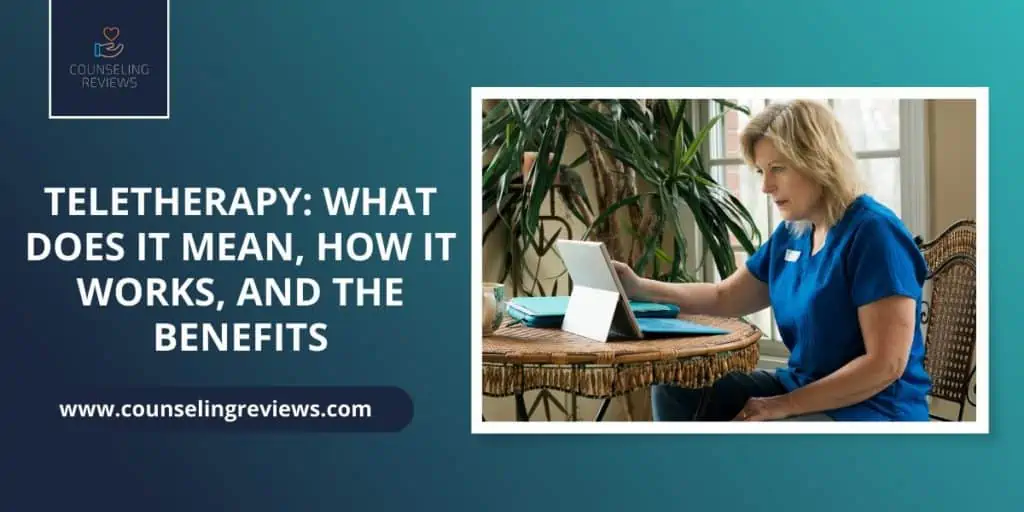When online chatting via camera became a thing in the 90s, many people grabbed the opportunity to work online – including mental health workers. The beginnings of online therapies provoked many questions for mental health specialists that we’re happy to answer.
Many patients are skeptical about joining online therapies because they question the effects or simply because they feel uncomfortable.
Thought that you were the only one? You’re not.
In this text, we’re clearing the fog on Teletherapies and the questions it evoke. So, without further ado, let’s get the first one!
What is Teletherapy?
Teletherapy has the same practice model as regular therapy sessions, cognitive behavioral therapy, except that it’s based online instead of face-to-face. In teletherapy sessions, or online therapy, e-therapy, or video therapy – you have an online session with your therapists or counselor over the computer. It’s basically the same as FaceTiming your friends.
Ever since the 1990s, when Teletherapy first appeared, it was quickly adopted by the audience. Many patients found this method even more practical than face-to-face because they were in their safe zone, at home, and still working on improving their mental health.
Teletherapy doesn’t have a local restriction, and patients on this side of the world meet virtually with therapists on the other side. Patients had the opportunity to find quality therapists in real-time and outside their geolocation.

Let’s see how they made everything work smoothly and effectively.
How Do Online Therapy Sessions Work?
Online therapy has the same approach as offline therapy – only the client and the therapist aren’t in the same room. The opportunity to work remotely in the whole mental health care sector brought two possible ways of realization – synchronized and unsynchronized sessions
Synchronized Online Sessions
In this module, the therapist and the patient are both connected online at the same time. Both the therapist and the patient agree to meet online regardless of the difference in time zones, if any. Once they meet, the therapy flows as if both of them were together in person session the same room. The therapists would ask questions, take notes, and lead the therapy session using the same methods as their physical offices.
Unsynchronized Online Sessions
This module is more like a homework plan. The therapists usually give some kind of “homework” like meditations, writing journals, or coloring, where the patient must put effort on their own. Also, the therapist might recommend reading a book or getting informed on their mental illness, etc.
The unsynchronized sessions usually go with the synchronized therapists treating them as self-effort. Sessions won’t work unless the patient is willing to step outside their comfort zone and put effort into bettering their mental well-being.
Patients must complete their homework so that the therapist can track the patient’s improvement. Not finishing their duty is also feedback for distance therapy. So, the mix of these two methods practically makes online sessions work.
Who can provide teletherapy?
Teletherapy can be provided by licensed mental health professionals, including psychologists, counselors, social workers, and psychiatrists, who have the necessary qualifications and licenses to practice therapy. These professionals can offer remote mental health counseling services to clients through secure online platforms, ensuring that therapy remains confidential and effective.
Teletherapy has expanded access to mental health support, making it available to individuals who may have geographical or mobility constraints, thus broadening the pool of potential providers and recipients.
4 Benefits of Teletherapy for Patients
- Accessibility: Teletherapy eliminates geographical barriers, allowing patients to access mental health services from the comfort of their homes. This is especially valuable for individuals in remote areas or those with mobility issues.
- Convenience: Patients can schedule sessions at times that suit their busy lives, reducing the need for travel and time off work. This flexibility promotes better adherence to therapy.
- Privacy: Teletherapy provides a confidential environment, enhancing patients’ comfort and openness in discussing sensitive issues.
- Safety: During public health crises like COVID-19, teletherapy minimizes the risk of exposure to infections while ensuring continuous mental health support.
Online Therapies: Who is it For?
Online therapies are typically associated with people suffering from depression, anxiety, or other psychological distress. This is true – but it doesn’t have to define them.
Online therapies are suitable for patients with speech difficulties. Patients can easily follow the treatment and practice their speech as they normally would by meeting in real-time. On the other hand, parents with hyperactive children find this opportunity even better. They will hold phone therapy sessions without having to go through all the tantrums.
Ultimately, people suffering from mental distress also find this convenient. Usually, it’s always the room and the act of going to therapy that scares depressed people. It confirms their fears that there’s something wrong with them. In this case scenario, they won’t feel any different because they will practically talk to their therapist straight from their own home.
Teletherapy Privilege for Patients and Therapists
As mentioned, a Teletherapy session creates a comfy environment for patients. It establishes a healthy friend-to-friend relationship instead of a “hostile” therapist-to-patient.
Additionally, patients have a broader range to connect with qualified therapists online. And, they won’t have to wait for their turn, hoping they won’t run into someone they know.
As for therapists, they have flexible working hours. That gives therapists some time to relax and clear their minds from negative energy. Furthermore, they have the opportunity to improve career-wise. The internet offers a great opportunity to connect therapists with patients that will challenge them. Therapists will have to put in greater effort but still – help someone who needs it the most.
Teletherapy Privacy
Therapists have ethical and professional bound to hold their sessions and the data they collect privately. In that sense, they must ensure the environment and office space where they hold sessions is private.
Recording the sessions is not allowed unless the patient consents to it. Since we’re speaking of a virtual environment, patients and therapists sometimes must leave voice messages as an alternative communication medium. Afterward, the therapist can save or delete them, but that entirely depends on the patient’s will.
However, considering the traditional therapy sessions are held online – both patients and therapists are accountable for securing the environment to access therapy in. In light of all facts, both physical and virtual therapies have their pros and cons, with the virtual one definitely standing out in certain aspects!
Things to Consider
While teletherapy is increasingly recognized as an effective option, it may not suit everyone’s mental health needs. Serious conditions like substance use disorders, severe depression, and schizophrenia often demand more comprehensive treatment than online therapy can offer alone. Consulting your healthcare provider is essential to assess if e-therapy is suitable for your situation or if it should complement traditional treatment. If considering e-counseling, research available platforms to identify one that aligns with your requirements and budget.
Future of Teletherapy: How to Become A Teletherapist
The future of teletherapy services holds significant promise as it gain widespread acceptance and becomes a mainstream mode of mental health treatment. In our increasingly digital world, the convenience and accessibility of teletherapy make it an appealing option for both therapists and clients. With ongoing technological advancements, teletherapy is expected to become even more integrated into mental healthcare.
Becoming a teletherapist involves pursuing the necessary education and licensure in fields of mental health therapy like psychology, counseling, or social work. Specialized training in teletherapy techniques is vital to effectively deliver remote mental health support. Moreover, investing in secure technology and staying updated on legal and ethical considerations are essential steps. Building an online presence and robust marketing strategy will also be key to success in this evolving field.
Currently residing in Arizona, John shares his home with two beloved pets - a very cute dog and a cat. Although they don't always see eye-to-eye, John's furry companions bring him joy and inspiration, serving as a constant reminder of the importance of cultivating meaningful relationships.
With a keen eye for detail and an unwavering commitment to quality, John is a true asset to the counselingreviews.com team. Whether he's writing about the latest research on mental health or offering practical advice for managing stress, John's expertise and insight are always in high demand.
If you're looking for well-researched and informative content that can help you improve your mental and emotional well-being, be sure to check out John's articles on counselingreviews.com. His writing is sure to provide you with the guidance and inspiration you need to overcome life's challenges and achieve your goals.
- Interview with Gary Tucker: Navigating Eco-Anxiety in a Changing Climate - April 15, 2024
- Mental Health in the Age of TikTok: Experts’ Take - April 12, 2024
- Warning Signs of a Troubled Marriage - February 11, 2024




